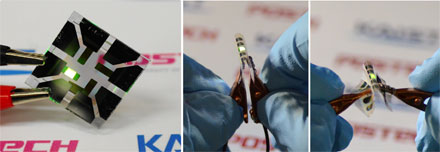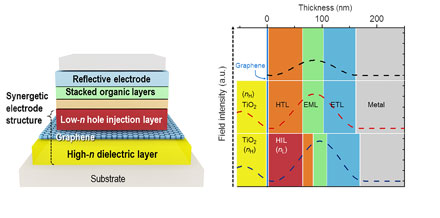Graphene-based OLED efficiency and flexibility have been shown to increase through a novel approach that uses graphene as a transparent electrode (TE) placed between titanium dioxide (TiO2) and conducting polymer layers.
To improve the efficiency of graphene-based OLEDs, researchers from Korea Advanced Institute of Science and Technology (KAIST) and Pohang University of Science and Technology (POSTECH) fabricated a transparent anode in a composite structure in which graphene electrodes were sandwiched between a TiO2 layer with a high refractive index (high-n), and a hole-injection layer (HIL) of conducting polymers with a low refractive index (low-n).

Application of Graphene-based OLEDs. This picture shows an OLED with the composite structure of TiO2/graphene/conducting polymer electrode in operation. The OLED exhibits 40.8 percent of ultrahigh external quantum efficiency and 160.3 lm/W of power efficiency. The device prepared on a plastic substrate shown in the right remains intact and operates well even after 1,000 bending cycles at a radius of curvature as small as 2.3 mm. Courtesy of Korea Advanced Institute of Science and Technology and Pohang University of Science and Technology.
This optical design induced a synergistic collaboration between the high-n and low-n layers to increase the effective reflectance of TEs. As a result, the enhancement of the optical cavity resonance was maximized, improving the efficiency and color gamut in OLEDs. At the same time, the loss from surface plasmon polariton (SPP), a major cause for weak photon emissions in OLEDs, was reduced due to the presence of the low-n conducting polymers.
Graphene-based OLEDs that were developed using this approach exhibited ultrahigh external quantum efficiency (EQE) of 40.8 and 62.1 percent (64.7 and 103 percent with a half-ball lens) for single- and multi-junction devices, respectively. Further, the OLEDs remained intact and operational even after 1,000 bending cycles at a radius of curvature as small as 2.3 mm, partly due to the TiO2 layers withstanding flexural strain up to 4 percent. Oxides are typically brittle and prone to bending-induced fractures even at a relatively low strain. However, the research team discovered that TiO2 has a crack-deflection toughening mechanism that tends to prevent bending-induced cracks from forming easily, enabling OLEDs to be highly flexible as well as efficient.

“What’s unique and advanced about this technology, compared with previous graphene-based OLEDs, is the synergistic collaboration of high- and low-index layers that enables optical management of both resonance effect and SPP loss, leading to significant enhancement in efficiency, all with little compromise in flexibility,” said KAIST professor Seunghyup Yoo.

Schematic Device Structure of Graphene-based OLEDs. This picture shows the new architecture to develop highly flexible OLEDs with excellent efficiency by using graphene as a transparent electrode (TE).Courtesy of Korea Advanced Institute of Science and Technology and Pohang University of Science and Technology.
POSTECH professor Tae-Woo Lee said, “We expect that our technology will pave the way to develop an OLED light source for highly flexible and wearable displays, or flexible sensors that can be attached to the human body for health monitoring, for instance.”
Graphene-based OLEDs have emerged as a key element in next-generation displays and lighting, mainly due to their promise as highly flexible light sources. Graphene’s atomic thinness leads to a high degree of flexibility and transparency, making it an ideal candidate for TEs. Nonetheless, the efficiency of graphene-based OLEDs reported to date has been, at best, about the same level of indium tin oxide-based OLEDs.
The research was published in
Nature Communications (
doi: 10.1038/ncomms11791).